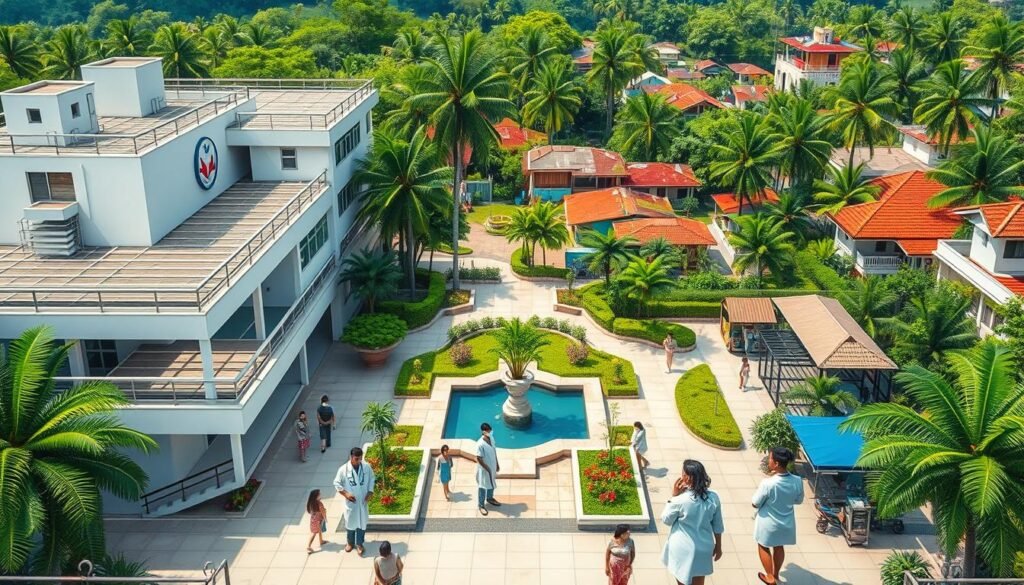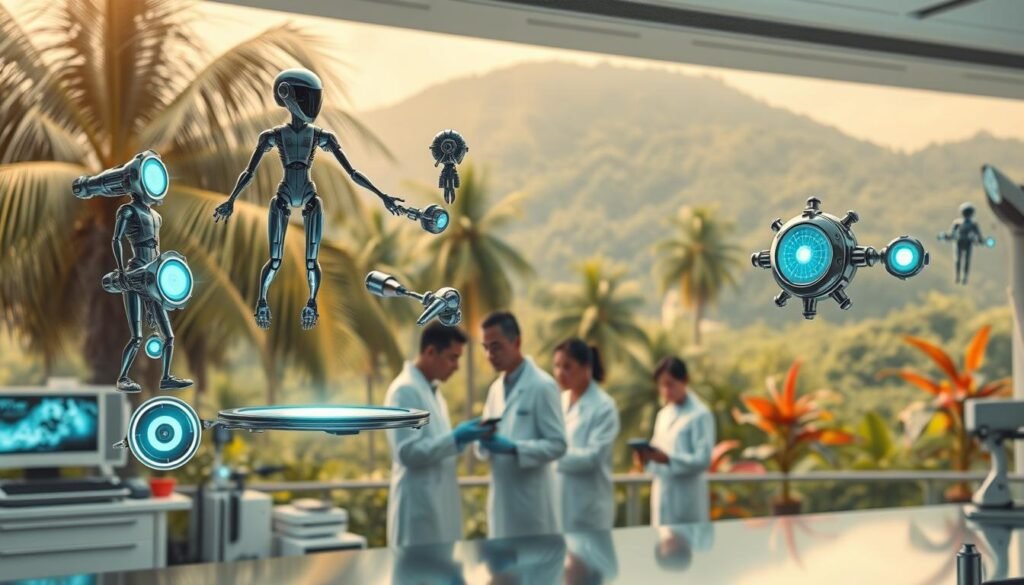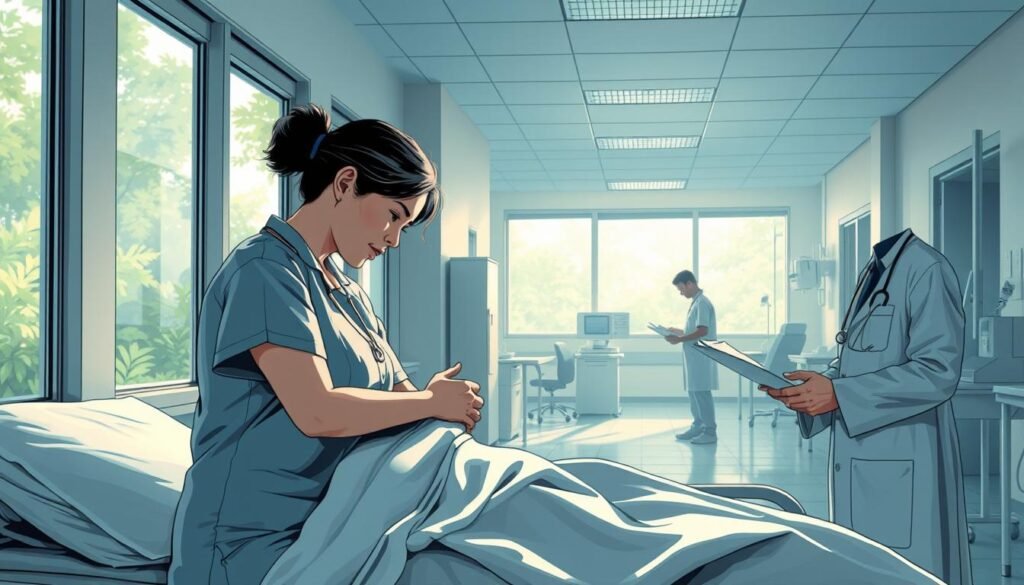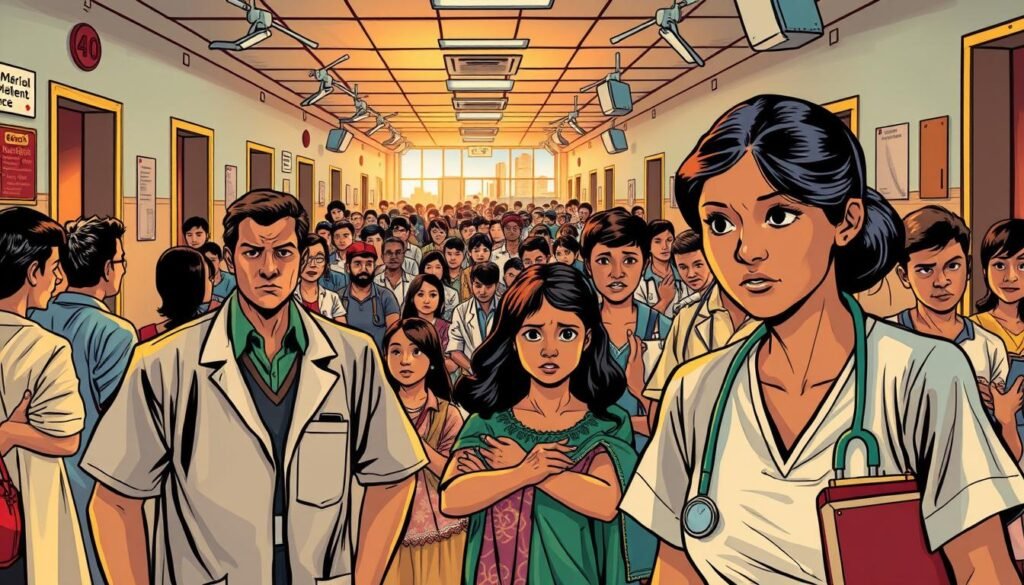The Philippines has seen significant advancements in healthcare over the years, largely influenced by American practices. From traditional healing methods to modern biomedical science, the journey has transformed how patients receive care.
American medicine introduced cutting-edge technologies and research, improving diagnosis and treatment methods. This integration has enhanced the overall health system, making it more efficient and accessible.
Symbols like the Rod of Asclepius remind us that medicine is both an art and a science. These changes have not only improved patient outcomes but also set new standards for service delivery.
This introduction lays the foundation for exploring how American practices continue to shape the Philippines’ healthcare landscape, ensuring better care for all.
Key Takeaways
- American healthcare practices have significantly influenced the Philippines.
- Modern biomedical research has improved diagnosis and treatment methods.
- The integration of prevention and care has enhanced patient outcomes.
- Symbols like the Rod of Asclepius highlight medicine as both science and art.
- These advancements have set new standards for healthcare service delivery.
The Historical Journey of American Healthcare in the Philippines
The roots of American healthcare in the Philippines trace back to the colonial era. During this time, American practices began to merge with local traditions, creating a unique blend of care. This integration laid the foundation for the modern health system we see today.
Colonial Legacies and Early Medical Practices
When the United States took control of the Philippines in 1898, they introduced new medical practices. These early efforts focused on combating widespread diseases like cholera and tuberculosis. Colonial authorities established hospitals and trained local healthcare workers, marking the first steps toward a structured system.
Traditional healing methods, such as herbal remedies and folk practices, were still widely used. However, the introduction of American science and clinical protocols began to shift local practices. This period saw the gradual adoption of modern diagnosis and treatment methods.

The Shift to Modern Medical Systems
By the mid-20th century, the Philippines had embraced a more structured approach to healthcare. American influence played a key role in this transformation. Biomedical research, advanced drugs, and innovative medication became integral parts of the system.
Infrastructure improvements, such as the construction of modern hospitals, further enhanced patient care. Policies promoting health education and service delivery also contributed to this shift. Today, the Philippines continues to benefit from these advancements, ensuring better care for its people.
- Early colonial efforts focused on disease control and hospital establishment.
- Traditional practices gradually integrated with modern medical science.
- Biomedical research and advanced treatments reshaped healthcare delivery.
- Infrastructure and policy changes improved patient outcomes.
Innovations Transforming Treatment and Patient Care
Recent breakthroughs in healthcare technology are reshaping patient care in the Philippines. These advancements are improving how diseases are detected and treated, ensuring better outcomes for individuals. From advanced diagnostic tools to cutting-edge therapy methods, the landscape of healthcare is evolving rapidly.

Advanced Diagnostic Tools and Therapeutic Techniques
Modern diagnostic equipment, such as computerized tests, has significantly improved the accuracy of diagnosis. For example, wearable devices now monitor vital signs in real-time, alerting doctors to potential health concerns. This early detection allows for timely treatment, reducing complications.
New therapeutic techniques, like minimally invasive procedures, are enhancing patient recovery. These methods reduce hospital stays and improve overall care. The integration of technology into clinical practice ensures safer and more effective therapy options.
Adoption of Cutting-Edge Medication and Procedures
The use of innovative drugs and treatments is transforming patient care. For instance, novel anti-biofilm agents are addressing chronic infections, improving outcomes for millions. Remote monitoring systems also allow patients to manage their health from home, reducing the need for frequent hospital visits.
These advancements streamline the process of care delivery, making it more efficient and accessible. By embracing these innovations, the Philippines is setting new standards in healthcare service, ensuring better treatment for all.
Medicine: Enhancing Patient Outcomes in Philippine Healthcare
Enhanced safety measures and modern techniques are reshaping patient care in the Philippines. The integration of advanced protocols and systematic improvements has significantly improved health services, ensuring better outcomes for patients across the country.

Improved Health Services and Safety Measures
Modern healthcare practices have introduced rigorous safety measures in hospitals and clinics. For example, diagnostic tests like blood analysis and imaging are now more accurate, reducing risks in treatment. These advancements ensure timely and effective care for patients.
Systematic safety protocols, such as regular sterilization and infection control, are now standard. These measures lower the risk of complications and improve overall patient health. Continuous testing and laboratory analysis play a critical role in maintaining quality outcomes.
Technology has also streamlined service delivery. Remote monitoring systems allow doctors to track patient health in real-time, ensuring timely interventions. This approach enhances care while minimizing risks associated with delayed treatment.
Preventative care has seen significant advancements. Programs focusing on early diagnosis and prevention have reduced the burden of chronic diseases. For instance, routine screenings for children and adults have improved early detection rates, leading to better treatment outcomes.
These improvements are reflected in patient satisfaction levels. Surveys show significant increases in satisfaction with appointment scheduling, follow-up care, and overall service quality. This demonstrates the tangible benefits of integrating modern practices into healthcare delivery.
By adopting these measures, the Philippines is setting new standards in patient care. The focus on safety, accuracy, and efficiency ensures a healthier future for all.
Bridging Technology with Traditional Health Approaches
The fusion of technology and traditional health practices is reshaping healthcare in the Philippines. This integration offers a holistic approach to patient care, combining the best of both worlds. By blending modern advancements with time-tested methods, the healthcare system is becoming more effective and accessible.

Integrative Practices and the Role of Alternative Medicine
Integrative practices are gaining traction as they combine conventional and alternative methods. For example, doctors now use modern diagnostic tools alongside traditional healing techniques like herbal remedies. This approach ensures a more comprehensive treatment plan for patients.
Technology plays a crucial role in enhancing these practices. Wearable devices and remote monitoring systems allow doctors to track patient health in real-time. This data complements traditional methods, providing a fuller picture of a person’s health.
“The integration of technology and traditional medicine is not just a trend; it’s a necessity for modern healthcare.”
Food and lifestyle also play a significant role in traditional healing. Many alternative practices focus on the body’s natural balance, emphasizing the importance of diet and exercise. Modern healthcare systems are now incorporating these principles into their care plans.
Here’s a comparison of traditional and modern healthcare practices:
| Aspect | Traditional Practices | Modern Practices |
|---|---|---|
| Diagnosis | Observation and herbal knowledge | Advanced imaging and lab tests |
| Treatment | Herbal remedies and lifestyle changes | Pharmaceutical drugs and surgeries |
| Prevention | Diet and natural therapies | Vaccinations and health screenings |
The use of digital health tools has further strengthened this integration. These tools provide balanced information, helping patients make informed decisions about their care. For instance, AI-powered apps can analyze symptoms and suggest both modern and traditional treatment options.
Doctors and practitioners are now trained to navigate both biomedical and alternative methods. This dual expertise ensures that patients receive the best possible care, tailored to their needs. The result is a healthcare system that is more adaptable and patient-centered.
In conclusion, bridging technology with traditional health approaches offers a promising way forward. By combining the strengths of both systems, the Philippines is setting new standards in healthcare, ensuring better outcomes for all.
Influential Leaders and Collaborative Efforts in Healthcare
Collaborative efforts and visionary leadership have played a pivotal role in advancing healthcare in the Philippines. Key figures and cross-cultural partnerships have reshaped medical policy and practice, ensuring better care for patients.

Key Figures Shaping Medical Policy and Practice
Leaders like Gregory Adams and Nancy Agee have transformed healthcare systems through innovation and policy changes. For example, Adams oversees Kaiser Permanente, a network of 39 hospitals, while Agee manages a $2 billion integrated health system. Their work has improved service delivery and patient outcomes.
Robert Allen’s Intermountain Health connects teams across seven states, fostering collaboration. Similarly, Maria Ansari focuses on data and AI to enhance diagnosis and treatment. These leaders demonstrate how strategic vision can elevate healthcare systems.
Cross-Cultural Partnerships and Their Impact
Cross-cultural collaborations between American and Philippine healthcare professionals have driven significant improvements. For instance, joint initiatives in therapy and drug development have enhanced treatment options. These partnerships combine modern science with traditional practices, creating a holistic approach to care.
Projects like the integration of remote monitoring systems in Philippine hospitals showcase the effect of shared information. Such efforts streamline the process of care delivery, making it more efficient and accessible.
| Leader | Contribution | Impact |
|---|---|---|
| Gregory Adams | Oversees Kaiser Permanente | Improved service delivery |
| Nancy Agee | Manages $2 billion health system | Enhanced patient outcomes |
| Robert Allen | Connects teams across states | Fostered collaboration |
These collaborative efforts set a benchmark for future progress in healthcare. By combining leadership and innovation, the Philippines continues to improve its health system, ensuring better care for all. For more insights on the importance of collaboration in healthcare, explore this resource.
Challenges and Future Directions for American Medicine in the Philippines
The integration of American healthcare practices in the Philippines faces significant challenges that must be addressed to ensure equitable access and effective care. Financial barriers, systemic limitations, and the rapid adoption of new technologies without adequate infrastructure pose risks to the health system. Balancing innovation with accessibility is crucial for improving patient outcomes and maintaining the quality of care.

Overcoming Financial and Systemic Barriers
Financial constraints are a major hurdle in implementing advanced American medicine in the Philippines. High costs of pharmaceuticals and healthcare services often lead to inequities in treatment options. For example, many patients face substantial out-of-pocket expenses, making it difficult to access necessary care. This issue is particularly acute in low-income and vulnerable populations.
Systemic limitations, such as inadequate infrastructure and a shortage of trained healthcare professionals, further exacerbate the problem. In geographically isolated and disadvantaged areas (GIDA), the lack of health facilities and trained personnel contributes to poor health outcomes. Addressing these challenges requires targeted policies and better funding for health services.
Balancing Innovation with Accessibility
The rapid adoption of new technologies in healthcare can improve diagnosis and treatment, but it also carries risks. Without proper infrastructure and training, the benefits of these innovations may not reach all patients. For instance, advanced diagnostic tools and remote monitoring systems require reliable internet and technical expertise, which are not always available in rural areas.
Strategies for preventing adverse effects and ensuring safety in innovative treatment methods are essential. Regular training for healthcare professionals and the development of robust safety protocols can mitigate these risks. Additionally, integrating traditional practices with modern medicine can provide a more holistic approach to patient care.
“The integration of technology and traditional medicine is not just a trend; it’s a necessity for modern healthcare.”
Here’s a comparison of challenges and strategies in healthcare:
| Challenge | Strategy |
|---|---|
| High costs of pharmaceuticals | Better funding and government procurement strategies |
| Inadequate infrastructure | Investment in health facilities and technology |
| Shortage of trained professionals | Training programs and incentives for healthcare workers |
| Rapid adoption of new technologies | Safety protocols and regular training |
In conclusion, addressing the challenges in the Philippine healthcare system requires a balanced approach that combines innovation with accessibility. By focusing on financial sustainability, infrastructure development, and the integration of traditional practices, the Philippines can ensure better care for all its citizens. For more insights on the challenges faced by the healthcare system in remote areas, explore this resource.
Conclusion
American healthcare practices have profoundly shaped the Philippines’ medical landscape, blending innovation with tradition. From advanced diagnosis tools to integrative therapy methods, these changes have enhanced patient outcomes and streamlined care delivery. The fusion of technology with local practices ensures a holistic approach to health.
Collaborations between American and Filipino professionals have driven significant improvements in treatment and service quality. However, challenges like financial barriers and infrastructure gaps remain. Addressing these issues is crucial for ensuring equitable access to modern medicine.
Looking ahead, continuous innovation and integration will be key to sustaining progress. By prioritizing accessibility and collaboration, the Philippines can build a resilient healthcare system. For more insights on improving medical technology utilization, explore this resource.
FAQ
How has American medicine influenced healthcare in the Philippines?
American medicine has significantly shaped the Philippines’ healthcare system by introducing modern practices, advanced diagnostic tools, and innovative treatment methods. This influence has improved patient care and health outcomes across the country.
What role did colonial legacies play in the development of Philippine healthcare?
Colonial legacies laid the foundation for the Philippines’ healthcare system by establishing early medical practices and institutions. These efforts evolved into the modern medical systems seen today.
What are some cutting-edge innovations transforming treatment in the Philippines?
Innovations like advanced diagnostic tools, therapeutic techniques, and modern medications have revolutionized treatment. These advancements enhance accuracy, efficiency, and patient recovery rates.
How has the integration of technology and traditional health approaches benefited patients?
Combining technology with traditional methods has created a holistic approach to healthcare. This integration ensures patients receive comprehensive care that respects cultural practices while leveraging modern advancements.
Who are the key figures shaping healthcare policy in the Philippines?
Influential leaders, including policymakers, medical professionals, and international collaborators, have played pivotal roles in shaping healthcare policies and practices in the Philippines.
What challenges does the Philippines face in adopting American medical innovations?
Challenges include financial constraints, systemic barriers, and ensuring accessibility for all. Balancing innovation with affordability remains a critical focus for the future.
How do cross-cultural partnerships impact healthcare in the Philippines?
Cross-cultural partnerships foster knowledge exchange, resource sharing, and collaborative efforts. These partnerships enhance the quality and reach of healthcare services in the Philippines.
What safety measures have been implemented to improve health services?
Enhanced safety measures, such as strict hygiene protocols, advanced diagnostic testing, and patient monitoring systems, have been introduced to ensure safer and more effective healthcare delivery.
Source Links
- Addressing the Health Needs of High-Risk Filipino Americans in the Greater Philadelphia Region
- Traditional Medicine in the Colonial Philippines: 16th to the 19th Century. By Ma. Mercedes G. Planta. Quezon City, Philippines: University of the Philippines Press, 2017. xxx, 249 pp. ISBN: 9789715428255 (paper). | The Journal of Asian Studies | Cambridge Core
- Health of Filipino Americans
- Lifestyle Medicine Philippines: A Journey of Hope
- Filipino Americans: Significant Contributions to US Healthcare System
- 17 top healthcare innovations 2024, identified by the R&D community
- Patient Care Innovation
- Promoting equitable and patient-centred care: an analysis of patient satisfaction in urban, rural and remote primary care sites in the Philippines
- Experiences from the Philippine grassroots: impact of strengthening primary care systems on health worker satisfaction and intention to stay – BMC Health Services Research
- How medical technology is bridging the accessibility gap – MedTech Europe
- The Impact of Digital Health Solutions on Bridging the Health Care Gap in Rural Areas: A Scoping Review
- AI: Bridging Ancient Wisdom and Modern Innovation in Traditional Chinese Medicine
- Great leaders in healthcare | 2024
- Nurturing Leadership in Healthcare
- Collective leadership to improve professional practice, healthcare outcomes and staff well‐being
- Developmental Changes in the Philippine Health System: Accomplishments, Successes and Challenges
- Challenges Facing the Health System and Implications for Educational Reform – Health Professions Education: A Bridge to Quality
- Philippines – Healthcare
- Conclusion – Complementary and Alternative Medicine in the United States
- Conclusion | Who Will Keep the Public Healthy?: Educating Public Health Professionals for the 21st Century
- Discussion and conclusion

